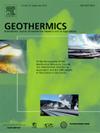相变材料和非相变材料钢管能量桩群热力学性能试验研究
IF 3.5
2区 工程技术
Q3 ENERGY & FUELS
引用次数: 0
摘要
能源桩作为一种低碳、环保、低成本的地下能源结构引起了全球的关注。然而,对钢管能量桩群的热力学性能研究较少。通过室内模型试验,分析比较了钢管混凝土能量桩组(SPEPG)和钢管相变混凝土能量桩组(SCEPG)在热平衡循环(加热幅度与冷却幅度不同)下的热力学性能。结果表明:在第三加热阶段,SPEPG的换热功率稳定在73.3 W,比SPEPG的换热功率提高了16%;在冷却阶段,SPEPG的换热功率稳定在96.7 W,比SPEPG高18%。此外,群桩中每根桩的平均换热效率低于单根桩,当桩间距为桩径的4倍时换热效率最大。在力学性能方面,SPEPG和SCEPG的最大热致应力分别为485.0 kPa和441.3 kPa,分别占钢管桩设计抗拉强度的2.3%和2.1%。钢管能量桩群的桩头位移主要由第一次循环后的位移决定,桩头位移的积累速率随着循环次数的增加而减小。经过3次循环后,与SPEPG相比,SCEPG的桩顶位移减小了9.1%。本研究为有无相变材料的钢管能源桩群在炎热气候地区的应用提供了参考。本文章由计算机程序翻译,如有差异,请以英文原文为准。
Experimental study on the thermo-mechanical behavior of steel pipe energy pile groups with and without phase change material
Energy piles have attracted global interest as a low-carbon, environmentally friendly and cost-effective underground energy structure. However, there were fewer studies on the thermo-mechanical behavior of steel pipe energy pile groups. The thermo-mechanical behavior of steel pipe concrete energy pile groups (SPEPG) and steel pipe phase change concrete energy pile groups (SCEPG) have been analyzed and compared by means of an indoor model test under thermal imbalance cycles (heating with different amplitude than cooling). The results indicated that by the third heating phase, the heat exchange power of the SCEPG stabilized at 73.3 W, which was 16% higher than that of the SPEPG. During the cooling phase, the heat exchange power of the SCEPG was stable at 96.7 W, which was 18% higher than that of the SPEPG. Furthermore, the average heat exchange efficiency of each pile in the pile group was lower than that of a single pile, with the maximum heat exchange power occurring when the pile spacing was four times the pile diameter. In terms of mechanical performance, the maximum thermally induced stress applied to the SPEPG and SCEPG were 485.0 kPa and 441.3 kPa, respectively, accounting for 2.3% and 2.1% of the design tensile strength of the steel pipe pile. The pile head displacement of the steel pipe energy pile groups was primarily determined by the displacement after the first cycle, and the accumulation rate of pile head displacement decreases as the number of cycles increases. After three cycles, the pile head displacement of the SCEPG decreased by 9.1% compared to that of the SPEPG. This study provides a reference for the application of steel pipe energy pile groups with and without phase change material in hot climate regions.
求助全文
通过发布文献求助,成功后即可免费获取论文全文。
去求助
来源期刊

Geothermics
工程技术-地球科学综合
CiteScore
7.70
自引率
15.40%
发文量
237
审稿时长
4.5 months
期刊介绍:
Geothermics is an international journal devoted to the research and development of geothermal energy. The International Board of Editors of Geothermics, which comprises specialists in the various aspects of geothermal resources, exploration and development, guarantees the balanced, comprehensive view of scientific and technological developments in this promising energy field.
It promulgates the state of the art and science of geothermal energy, its exploration and exploitation through a regular exchange of information from all parts of the world. The journal publishes articles dealing with the theory, exploration techniques and all aspects of the utilization of geothermal resources. Geothermics serves as the scientific house, or exchange medium, through which the growing community of geothermal specialists can provide and receive information.
 求助内容:
求助内容: 应助结果提醒方式:
应助结果提醒方式:


